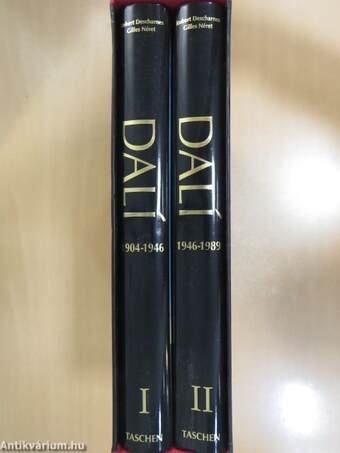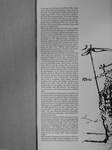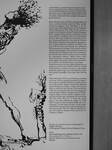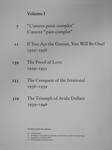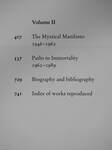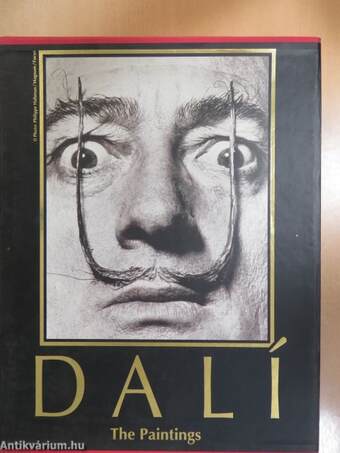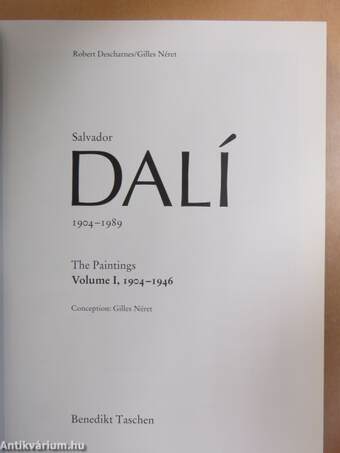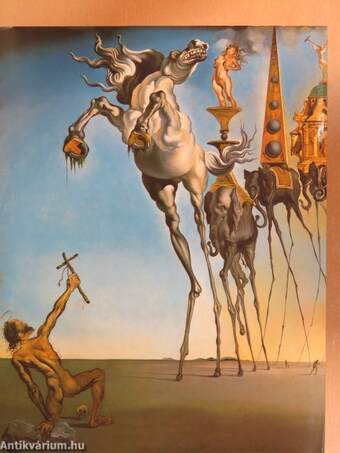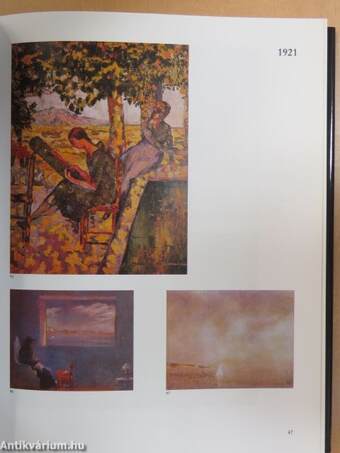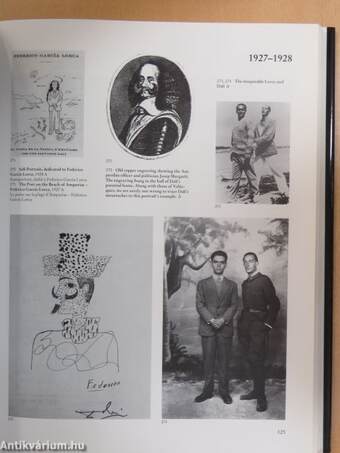1.067.053
kiadvánnyal nyújtjuk Magyarország legnagyobb antikvár könyv-kínálatát

VISSZA
A TETEJÉRE
JAVASLATOKÉszre-
vételek
Salvador Dalí 1904-1989 I-II.
The Paintings Volume I, 1904-1946/Volume II, 1946-1989
| Kiadó: | Benedikt Taschen Verlag GmbH |
|---|---|
| Kiadás helye: | Köln |
| Kiadás éve: | |
| Kötés típusa: | Vászon |
| Oldalszám: | 780 oldal |
| Sorozatcím: | |
| Kötetszám: | |
| Nyelv: | Angol |
| Méret: | 32 cm x 25 cm |
| ISBN: | 3-8228-9316-1 |
| Megjegyzés: | Színes és fekete-fehér fotókkal, reprodukciókkal gazdagon illusztrálva. Eredeti kiadói védődobozban. |
naponta értesítjük a beérkező friss
kiadványokról
naponta értesítjük a beérkező friss
kiadványokról
Fülszöveg
At the age of six, Salvador Dali (1904-1989) wanted to be a cook, and at seven Napoleon. "Since then," he later said, "my ambition has steadily grown, and my megalomania with it. Now I want only to be Salvador Dali, I have no greater wish." His whole life long, Dali was out to become Dali: that is, to be a genius, one of the most significant artists of the 20th century, beside Picasso and Matisse. In his own words: "Oh, Salvador, now you know the truth: that if you act the genius, you will be one!"
This study of Salvador Dali's art is the most complete edition of his known paintings ever published. It is not, however, a catalogue raisonné in the classic sense. Rather, it contextualizes Dali's work, teasing out its meanings by examining numerous contemporary documents of very different kinds: writings and drawings supplementary to the main Dali ouvre, as well as material relating to his versatile work in other areas of art, from ballet and cinema to fashion, advertising, and... Tovább
Fülszöveg
At the age of six, Salvador Dali (1904-1989) wanted to be a cook, and at seven Napoleon. "Since then," he later said, "my ambition has steadily grown, and my megalomania with it. Now I want only to be Salvador Dali, I have no greater wish." His whole life long, Dali was out to become Dali: that is, to be a genius, one of the most significant artists of the 20th century, beside Picasso and Matisse. In his own words: "Oh, Salvador, now you know the truth: that if you act the genius, you will be one!"
This study of Salvador Dali's art is the most complete edition of his known paintings ever published. It is not, however, a catalogue raisonné in the classic sense. Rather, it contextualizes Dali's work, teasing out its meanings by examining numerous contemporary documents of very different kinds: writings and drawings supplementary to the main Dali ouvre, as well as material relating to his versatile work in other areas of art, from ballet and cinema to fashion, advertising, and objets d'art. Without these crutches to support analysis (to borrow a favourite Dali motif), the paintings would be simply so many images. Volume I examines the early Dali, an unknown artist whose skill and command were astounding. The young Dali deployed all the isms - Impressionism, Pointillism, Cubism, Fauvism, Purism and Futurism - with breathtaking ludic mastery. He would borrow from the prevailing trends, ridicule them, and drop them. Then he met the woman who was to be the great love of his life: Gala, his Muse, the custodian of his art. And he discovered Surrealism, which assisted the development of his famous paranoiac-critical method, which he derived from Freudian theory. The method called for the use of memories deep in the unconscious: Dali retrieved them and bodied them forth as enigmatic visual images, puzzling paintings that became increasingly fantastic, possessed, even insane. This was the period of soft watches and burning giraffes, the period when his Venus de Milo came with drawers - the drawers of the unconscious, which Dali made a point of pulling open.
It was not long before Dali became too surreal for the Surrealists and was excluded from their ranks. To the Surrealists in general, and André Breton in particular, it was vexing to find that the public was suddenly identifying Dali as the sole authentic representative of the movement. To the Spanish artist himself, their differences were expressible in simple terms: "The only difference between me and a madman is that I am not mad," he declared, and again, with equal truth: "The only difference between the Surrealists and me is that I am a Surrealist." And indeed Dali's Surrealism was total.
The American reception of Dali was quick to assess him accurately, and critics were soon distinguishing between Surrealism before and after Dali. He himself wrote in confirmation of their views: "the soft, deliquescent ornamentation, the gluey, the biological, putrefaction - was Dalinian. A bizarre anguishing glance discovered in a painting by Le Nain was Dalinian. The bread of Paris was no longer the bread of Paris. It was my bread, Dali's bread, Salvador's bread."
Dali was now in the grip of a sole obsession. Since the Surrealists no longer wanted anything to do with him, he set out to show what he could do for a new
world willing to acclaim his genius: America. In return he expected America to shower dollars on him -and earned André Breton's notorious anagram of the Spaniard's name: Avida Dollars. Dali became the hub of scandal, a seeker after fame and gold, and a greater genius than ever.
Robert Descharnes (born 1926) is a photographer and writer, and has directed numerous films, notably L'histoire prodigieuse de la dentelliere et du rhinocéros (The Amazing Adventure of the Lacemaker and the Rhinoceros; 1954-1962). He has written a number of art books (on Antoni Gaudi and Auguste Rodin, among others) and has contributed a great many articles to leading French and international journals. Above all, though, he is the author and editor of major publications on the work of Salvador Dali. Robert Descharnes has assisted in the preparation of Dali exhibitions at galleries worldwide, and since 1950 has been documenting and cataloguing Dali's paintings and writings. He has created a unique archive of photographic, film and sound material on the life and work of Salvador Dali. He is a member of the Gala-Salvador Dali Foundation, and is its officer for international relations. Shortly before Dali's death, Descharnes was appointed by him to administer the rights to his works, within the Société Demart Pro Arte B.V., of which Descharnes is president. Robert Descharnes now has a global reputation as an authority on the work of Salvador Dali. As a friend of the artist for over thirty years, privy to the realities behind the public image, he is one of the few to have had intimate knowledge of the other Dali: Dali the
Gilles Néret (born 1933) is an art historian, journalist and writer. He has organized numerous retrospectives in Japan, including a Dalí show in 1964, and was one of the founder members of the Seibu Museum and the Wildenstein Gallery in Tokyo. He has been editor-in-chief and then director of the periodicals L'Oil and Connaissance des Arts. His monographs include studies of Manet, Toulouse-Lautrec, Renoir, Cézanne, Klimt, Picasso, Rodin, Lempicka, Botticelli, David, Dali, Léger and Matisse. He received the 1981 Elie Faure Prize for A l'école des grands peintres. His other publications include Les Naifs (NEF, Paris); Les Impressionnistes (Office du Livre, Fribourg); L'Art des années 20 and L'Art des années 30 (Seuil, Paris; Rizzoli, New York; Orell Fiissli, Zurich); Avant-garde 1945-1975 (Hirmer, Munich); 30 Ans d'art moderne (Nathan, Paris); and Erotic Art (Taschen, Cologne).
The gift case reproduction uses a photograph by Philippe Halsman.
© Photograph: Philippe Halsman/Magnum/Focus Cover.
The Temptation of St. Anthony (detail), 1946 Oil on canvas, 89.7 x 119.5 cm Brussels, Musees Royaux des Beaux-Arts de Belgique
Vissza
Témakörök
- Életrajz > Művészet > Festészet, szobrászat
- Idegennyelv > Idegennyelvű könyvek > Angol > Művészetek > Festészet
- Idegennyelv > Idegennyelvű könyvek > Angol > Művészetek > Művészettörténet, általános
- Idegennyelv > Idegennyelvű könyvek > Angol > Életrajz > Művészet > Festészet, szobrászat
- Művészetek > Művészettörténet általános > Idegen nyelv > Angol
- Művészetek > Művészettörténet általános > Életrajzok > Festők
- Művészetek > Festészet > Korszakok, stílusok > XX. század > Avantgárd > Szürrealizmus
- Művészetek > Festészet > Életrajzok > Külföldi
- Művészetek > Festészet > Idegen nyelv > Angol
- Művészetek > Festészet > Általános festészet > Története
Megvásárolható példányok
Nincs megvásárolható példány
A könyv összes megrendelhető példánya elfogyott. Ha kívánja, előjegyezheti a könyvet, és amint a könyv egy újabb példánya elérhető lesz, értesítjük.



